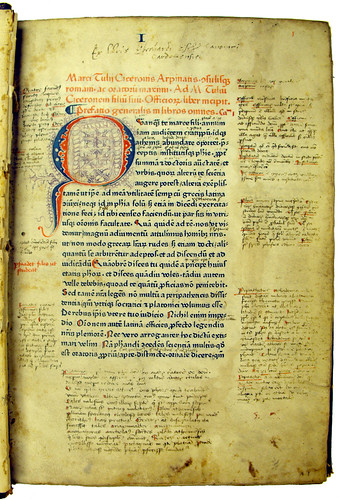Cicero, Marcus Tullius: De officiis.
Add: Paradoxa Stoicorum. Hexasticha XII Sapientum de titulo Ciceronis. Horatius Flaccus: Ad T. Manlium Torquatum (Carm. IV 7).
[Mainz]: Johann Fust and Peter Schoeffer, 4 Feb. 1466.
Fol. [1-118]. [88] leaves.
ISTC ic00576000; Goff C576; BMC I 24; Bod-inc C-308; GW 6922.
| Shelf-mark: | Sp Coll Hunterian Bg.2.24 (see main library entry for this item) |
| Note: | Printed on vellum (see Joseph van Praet, 'Catalogue des livres imprimés sur vélin de la Bibliothèque du Roi', 6 vols (Paris: 1822-8), vol. II, no. 74.22, p. 57). |
| Note: | Printer's pin-holes visible. |
| Provenance: | Eberhard Esch (15th/16th century), canonicus, Karden on the Moselle: inscription on 1/1r “Ex libris Eberhardi Esch Canonici Cardonensis”. Edward Harley (1689-1741), Lord Harley; from 1724 2nd Earl of Oxford: see Binding. Thomas Osborne (d. 1767), bookseller: top corner of first front flyleaf cut off - as in many other Harleian volumes - probably by Osborne to remove his earlier price; no. 5105 in 'Catalogus bibliothecae Harleianae', vol. I (London: 1743). Philip Carteret Webb (1702-1770), barrister, FSA, FRS: armorial book-plate; Webb’s shelf-mark ‘N----8’ on front flyleaf; sale (1771), lot 2055 (‘impress. in membrana’). William Hunter (1718-1783), physician and anatomist: source unknown, but perhaps bought by Hunter at the sale of Webb’s library in 1771. University of Glasgow: Hunterian bequest 1807; Hunterian Museum bookplate with former shelfmark “Av.4.17”. |
| Binding: | England, 18th-century gold-tooled red morocco. This copy and a second copy now in the King’s Library at the British Library were bound for Lord Harley 13 Jan. 1716/17 by Jane Steel for a total of £1.10.0 (see Nixon, ‘Harleian bindings’, p. 160). Both covers are decorated with three panels (the inner and middle panels joined by a double fillet line at the corners); the inner panel is outlined with a roll (Nixon, ‘Harleian bindings’, pl. 10, Steel roll 1) within a triple fillet; the second panel, outlined by a double fillet, has fleurons at each outer corner (Nixon, ‘Harleian bindings’, pl. 10, Steel 4 and 10) and side-pieces at each outer edge composed of triangular massed tooling (including Nixon, ‘Harleian bindings’, pl. 10, Steel nos 1a, 1b, 6, and 9), thereby decorating the outer panel which is bordered by a double fillet. The tooling of the spine compartments includes Nixon, ‘Harleian bindings’, pl. 10, Steel, nos 1a, 1b, and 7; the turn-ins are decorated with Nixon, ‘Harleian bindings’, pl. 10, Steel roll 2; marbled endpapers. Size: 268 x 190 mm. |
| Leaf size: | 255 x 177 mm. |
| Annotations: | Copious marginal and interlinear annotations in 15th-century hands - mainly in black ink often with red underlining, more occasionally in red ink (the latter in a different hand); occasional pointing hands and “nota” marks; leaves 1-86 foliated in red in an early hand; early manuscript signatures “a-l” in black ink (a few cropped by binder). NB. a sheet of paper loosely inserted in the Fust and Schoeffer, Mainz, 1465 edition of this work contains William Hunter’s manuscript notes in which he compares the typography of his copy of the 1465 edition with that of this copy of the1466 edition. |
| Decoration: | Seven-line initial ‘Q’ on 1/1r, seven-line initial ‘Q’ on 5/1r (f. 33r), six-line initial ‘P’ on 7/4r (f. 52r) and six-line initial ‘A’ on 10/4v (f. 76v) supplied in red and blue with reserved white, the body of the initials filled with violet pen-work decoration, which also extends into the margin; other initials supplied in red or blue (occasionally decorated with a human face); capital strokes and paragraph marks in red; running book numbers ‘I-III’ on rectos in alternate blue and red. |
| Imperfections: | None. |





